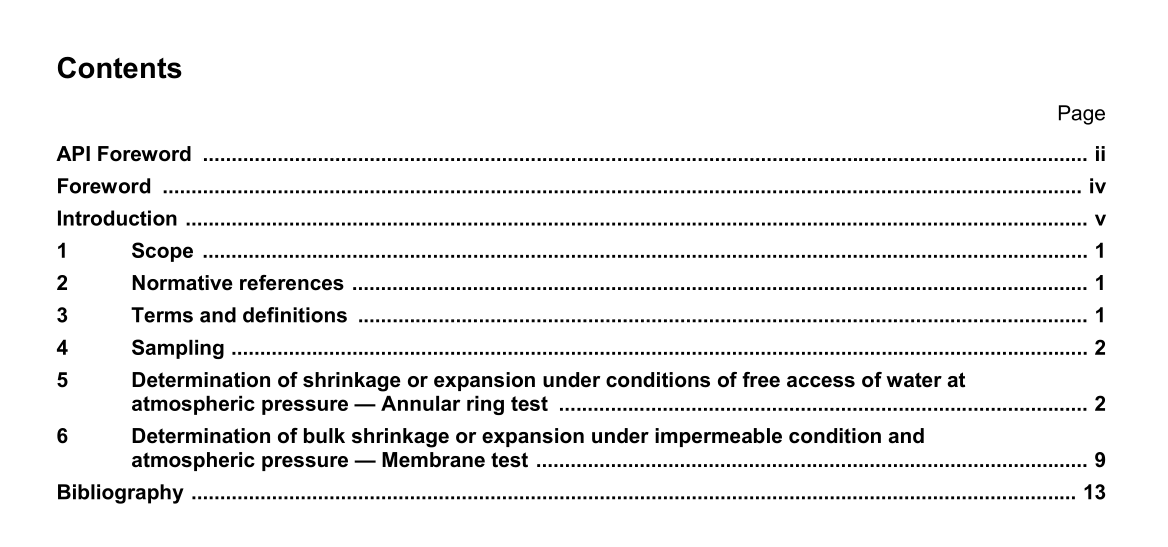ANSI API RP 10B-5 pdf download

ANSI API RP 10B-5 pdf download.Petroleum and natural gas industries — Cements and materials for well cementing
5.3.2 Preparation of slurry
5.3.2.1 Mixing Test samples shall be prepared in accordance with ISO 10426-2:2003, Clause 5. The mixing device shall be calibrated annually to a tolerance of ± 3,3 r/s (200 r/min) at 66,7 r/s (4 000 r/min) and ± 8,3 r/s (500 r/min) at 200 r/s (12 000 r/min). In addition to accurately controlling the mixing speed, the wear of the mixing blade should be monitored. As such, when the mixer blade has lost more than 10 % of its original mass, it shall be replaced. If larger slurry volumes are needed, an alternate method for slurry preparation is found in ISO 10426-2:2003, Annex A. As required, the density of the cement slurry can be determined by methods found in ISO 10426-2:2003, Clause 6. 5.3.2.2 Slurry conditioning After mixing, the cement slurry should be poured immediately into the slurry cup of an atmospheric consistometer for conditioning. The slurry cup should be initially at ambient temperature to avoid the possibility of thermally shocking temperature-sensitive slurries. The slurry shall be then heated to the desired test temperature of up to 88 °C (190 °F). The thickening time schedule that most closely simulates actual field conditions shall be followed; see ISO 10426-2:2003.
5.3.3 Curing at atmospheric pressure
The slurry, after it is heated at the desired test temperature, shall be re-stirred with a spatula to ensure uniformity. The slurry is poured into the large fill hole at the outer portion of the top of the ring mould (preheated to the test temperature in an oven). The small hole in the top of the mould is for venting air from the mould during filling. The mould is filled until the slurry exits the small hole. On some thicker slurries, the mould might need to be tapped or vibrated to ensure it is completely filled. If the slurry is too thick to pour freely, use a modified syringe to transfer the slurry into the mould through the large hole in the top of the ring mould. To make the modified syringe, cut off the tip of a 60 ml syringe and widen the opening to approximately 6,5 mm to 9,5 mm (1/4 in to 3/8 in). With the plunger inside the syringe, place the syringe into the thick slurry, slowly pull the plunger out to suck the slurry inside the syringe, and then eject it into the large hole of the mould. Repeat this process until the mould is filled completely. Once the slurry is poured, the mould is placed into a water bath that has been preheated to the test temperature. The slurry is in contact with water during the entire test. After curing, the sample is cooled to below 77 °C (170 °F). Water entry will compensate for any inner shrinkage as long as the cement matrix is permeable. If the cement expands during the hydration period the outside diameter of ring will expand.
5.3.4 Test period
The test period is the elapsed time from subjecting the sample to test temperature in the atmospheric consistometer to the time of final measurement at the end of curing time. Measurements may be made periodically to determine only the expansion and not the shrinkage profile.
5.4 Measurement and calculations
Before curing in the atmospheric bath, an initial measurement is taken with a micrometer immediately after the mould is filled with slurry. The micrometer (mounted on a height-adapter block) is opened and placed on the smooth, flat surface beside the mould to measure the distance between the outside of the steel balls attached to each side of the split in the expandable ring (with the spacer block in place, if used). After curing, another measurement is taken in the same manner as the initial measurement. If the spacer block is used, carefully remove it. Do not expand the outer expandable ring while removing the spacer block. The distance between the two steel balls is measured with a micrometer with a precision of 0,02 mm (0,001 in). This measurement shall be performed immediately (less than 5 min) after removal from the atmospheric curing bath or the 77 °C (170 °F) cooling bath to prevent the specimen from cooling significantly and causing an erroneous measurement. The micrometer shall be mounted on a block that can be placed on a counter top beside the mould so the measuring contact balls on the expandable ring are centred between the micrometer’s measuring contacts (Figures 7, 8, 9, 10 and 11). The use of a micrometer without the use of a special mount can result in erratic measurements.









